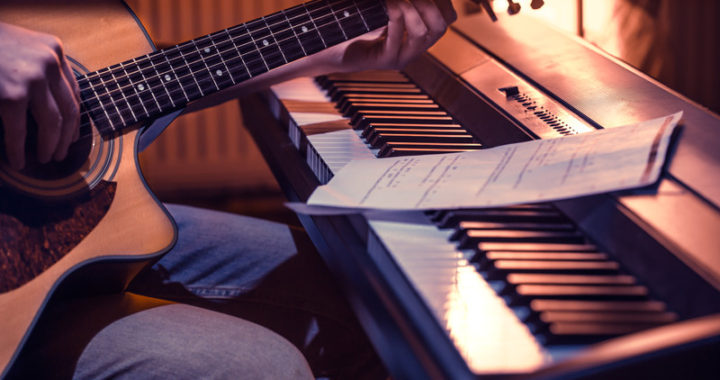No matter what genre you write in, there’s one thing that all songs have in common: they take listeners on a musical journey. That means that for every given moment within a song (assuming it’s well-written), listeners eagerly anticipate what’s going to happen next.
In other words, just like a real journey, where you are always wondering what’s going to be around the next corner, a good song entices us to wonder what’s going to happen in the next few seconds, and then the next few seconds after that, before finally coming to a satisfying end.
 Trying to get a handle on writing song lyrics? Discover the benefits of making a lyrics-first method your new go-to process with”Use Your Words! Developing a Lyrics-First Songwriting Process. It’s FREE right now when you purchase the 10-eBook Bundle.
Trying to get a handle on writing song lyrics? Discover the benefits of making a lyrics-first method your new go-to process with”Use Your Words! Developing a Lyrics-First Songwriting Process. It’s FREE right now when you purchase the 10-eBook Bundle.
If there are any glitches along the way, your listeners may lose interest in that journey. With a song, if there are any moments that don’t lead “logically” to the next moment, you risk having listeners lose interest in the musical journey you’re providing.
The trickiest moment within a song is when it transitions from one section to the next, and perhaps the trickiest of all is that transition from verse to chorus.We know that choruses are usually more energetic than verses, but there might be problems in this regard if:
- the basic range of the melody is dramatically different from the range of the chorus (e.g., if the melody is a lot lower than the verse of the chorus), or…
- the chorus melody is lower than the verse, or…
- the chords at the end of the verse don’t connect logically to the chords of the chorus, or…
- it’s hard to understand the connection between the verse and chorus lyrics, or…
- it’s hard to understand the connection between the instrumentation of the verse and the chorus.
I say might be a problem, because for every proposed glitch, there are probably a list of songs out there that do just fine even though, for example, the chorus melody is lower than the verse (Genesis, “No Reply At All”).
But most of the time, those five circumstances can provide moments of difficulty in keeping basic song energy moving in the right direction. If, in your own songs, you’ve discovered that there is a moment between verse and chorus where something’s not working, it’s likely to be one of those items in the list. And if you find that to be the case, here are some solutions:
- If your verse is a lot lower in pitch than your chorus, see if inserting a pre-chorus that works your melody upwards might work. (“Sweet Caroline”, by Neil Diamond, is a great textbook example of how this can work.)
- If you like the melody of your chorus, but the fact that it’s lower than your verse is draining a bit of musical energy away, try changing the key of your chorus to place the melody higher. (“You’re the Inspiration” – P. Cetera, D. Foster)
- If the chords at the end of your verse move awkwardly to the chorus, try some chord substitutions. Often the awkwardness comes from a key change, but even in dissimilar keys you should be able to find a chord that acts as a good pivot between the two keys. (I wrote a blog article about pivot chords many years ago: “Changing Key by Using a Pivot Chord“.)
- Chorus lyrics should, either literally or perhaps abstractly, answer and address any issues and situations that come up in verse lyrics. In that sense, chorus lyrics should act as a kind of logical follower for whatever happens in the verse. Abstract or complex lyrics are fine, and can be quite exciting. But there needs to be at least the sense that the chorus is responding to whatever has happened in the verse.
- If your chorus instrumental choices seem to come out of left field, with little or no connection to whatever has happened in the song before, it might be a problem. Sometimes a dramatic change from one section to the next can add the musical excitement you’re looking for. In”Come Sail Away“(Styx), there are pretty dramatic changes in instrumentation, but there’s a kind of “preparation” for those changes — little “builds” — that helps everything make sense.
In general, the ends of songs should exhibit more energy than their beginnings. You can use that as an important rule-of-thumb (and in fact, it’s one of the basic songwriting principles I talk about in my eBook ““The Essential Secrets of Songwriting”).
By listening to your own songs carefully you should be able to identify those moments when the changes you’ve put into your song are either too much for the given moment, or not enough, in such a way as it interferes with the basic flow of your song.
 Written by Gary Ewer. Follow Gary on Twitter
Written by Gary Ewer. Follow Gary on Twitter
 Practice makes perfect, but only if you aren’t reinforcing mistakes. Get going in the right direction – Get “The Essential Secrets of Songwriting” 10-eBook Deluxe Bundle, and this special deal.
Practice makes perfect, but only if you aren’t reinforcing mistakes. Get going in the right direction – Get “The Essential Secrets of Songwriting” 10-eBook Deluxe Bundle, and this special deal.










